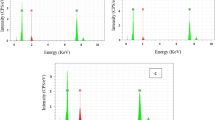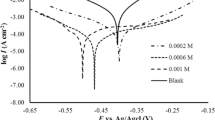Abstract
Corrosion problems in surface facilities are one of the most critical challenges of the oil industry. Recently, there has been an increase in new corrosion inhibitors, particularly nanocomposite inhibitors. This study aims to prepare a novel nanocomposite TiO2·B2O3-[TBID] as a corrosion inhibitor and investigate its effect on carbon steel (CS.45). This type of alloy was chosen, and the environmental conditions are similar to the conditions of the facilities of Halfaya oilfield in southern Iraq. Analytical techniques diagnosed the prepared nanocomposite, including X-ray diffraction, Energy dispersive X-ray atomic force microscopy technique, field emission scanning electron microscope, transmission electron microscope, FT-IR spectra and nuclear magnetic resonance spectroscopy 1H-NMR. The efficiency of the prepared corrosion inhibitor was evaluated using an electrochemical corrosion test cell (Tafel plots), and the working electrode was specimens of carbon steel (CS.45) at different inhibitor concentrations of 100, 200, 300, 400, and 500 ppm in (1 M) HCl solution at temperature 35 °C. The highest inhibition efficiency (IE%), 99.91%, was at a concentration of 100 ppm of TiO2·B2O3-[TBID] inhibitor in an acidic medium.











Similar content being viewed by others
References
Abdeen DH, El Hachach M, Koc M, Atieh MA (2019) A review on the corrosion behaviour of nanocoatings on metallic substrates. Materials 12(2):210
Abdullah HA (2014) Corrosion behavior of steel (St 37-2) by using natural products as inhibitors in petroleum medium. Diss. Department of Materials engineering, University of Technology
Adbulaziz SA, Alsammarraie AA (2016) Anticorrosion behavior of deposited nanostructured polythiophene on stainless steel, carbon steel, and aluminum in sea water. Int J Eng Res Sci (IJOER) 2(2):85–91
Al-Rashdi B, Tizaoui C, Hilal N (2012) Copper removal from aqueous solutions using nano-scale diboron trioxide/titanium dioxide (B2O3/TiO2) adsorbent. Chem Eng J 183:294–302
Ali AN, Alaa S, Hadi Z (2019) Synthesis, characterization and evaluation of some graphene oxide derivatives and their application as corrosion inhibitors for carbon steel alloy type C1025 in hydrochloric acid. Int J Corros Scale Inhib 8(4):974–997
Arun Kumar D, Merline Shyla J, Xavier FP (2012) Synthesis and characterization of TiO2/SiO2 nano composites for solar cell applications. Appl Nanosci 2(4):429–436
Aydoğdu G, Günendi G, Zeybek DK, Zeybek B, Pekyardımcı Ş (2014) A novel electrochemical DNA biosensor based on poly-(5-amino-2-mercapto-1, 3, 4-thiadiazole) modified glassy carbon electrode for the determination of nitrofurantoin. Sens Actuators B Chem 197:211–219
Ayyash AN (2014) Synthesis and characterization of some novel 4-thiazolidinones and isoxazolines derived from thiosemicarbazones. American J Org Chem 4(2):52–62
Basher NA (2020) Study of new derivatives of 1, 3, 4-Thiadiazole and Its Complexes with chromium ion (Cr+ 3). Paper presented at the IOP conference series: Materials Science and Engineering
Basher NA, Abdulkhabeer A (2022) Synthesis of novel demulsifier nano-materials and their application in the oil industry. Mater Today Proc 49:2842–2850
Basher NA, Ali AA (2022) Preparation and investigation of the corrosion inhibitor behavior of deposited nanocomposite on carbon steel in the oil industry. Egypt J Chem, pp 16.
Basher NA, Flifel IA, Mashaf AA (2020) Synthesis, characterization and antibacterial study of some complexes derivatives from1, 3, 4–Thiadiazole Schiff base. Paper presented at the IOP conference series: Materials Science and Engineering
Bray JD, Rodriguez-Marek A, Gillie JL (2009) Design ground motions near active faults. Bull N Z Soc Earthq Eng 42(1):1–8
Cen H, Chen Z, Guo X (2019) N, S co-doped carbon dots as effective corrosion inhibitor for carbon steel in CO2-saturated 3.5% NaCl solution. J Taiwan Inst Chem Eng 99:224–238
Chen C-C, Yen F-S, Huang C-Y (1994) Aging effects on the characteristics and sintering behavior of coprecipitated Al2O3▪ZrO2 powders. Ceram Int 20(6):379–384
Finšgar M, Jackson J (2014) Application of corrosion inhibitors for steels in acidic media for the oil and gas industry: a review. Corros Sci 86:17–41
Hua Y, Barker R, Neville A (2015) Comparison of corrosion behaviour for X-65 carbon steel in supercritical CO2-saturated water and water-saturated/unsaturated supercritical CO2. J Supercrit Fluids 97:224–237
Jeong J-H, Jung D-W, Shin EW, Oh E-S (2014) Boron-doped TiO2 anode materials for high-rate lithium ion batteries. J Alloy Compd 604:226–232
Kalfa OM, Yalçınkaya Ö, Türker AR (2009) Synthesis of nano B2O3/TiO2 composite material as a new solid phase extractor and its application to preconcentration and separation of cadmium. J Hazard Mater 166(1):455–461
Khamis EA, Hamdy A, Morsi RE (2018) Magnetite nanoparticles/polyvinyl pyrrolidone stabilized system for corrosion inhibition of carbon steel. Egypt J Pet 27(4):919–926
Klongdee J, Petchkroh W, Phuempoonsathaporn K, Praserthdam P, Vangnai AS, Pavarajarn V (2005) Activity of nanosized titania synthesized from thermal decomposition of titanium (IV) n-butoxide for the photocatalytic degradation of diuron. Sci Technol Adv Mater 6(3–4):290
Kundu V, Dhiman R, Maan A, Goyal D (2008) Structural and physical properties of Fe2 O3–B2 O3–V2 O5 glasses. Adv Condens Matter Phys 2008:1–7
Moulton M, Yu K, Braydich-Stolle L, Schlager J, Schrand A, Hussain S (2008) Effects of temperature, time, and solution on nanoparticle agglomeration. Paper presented at the APS Ohio Sections Spring Meeting Abstracts
Muti M, Gençdağ K, Nacak FM, Aslan A (2013) Electrochemical polymerized 5-amino-2-mercapto-1, 3, 4-thiadiazole modified single use sensors for detection of quercetin. Colloids Surf B 106:181–186
Park HK, Kim DK, Kim CH (1997) Effect of solvent on titania particle formation and morphology in thermal hydrolysis of TiCl4. J Am Ceram Soc 80(3):743–749
Quadri TW, Olasunkanmi LO, Fayemi OE, Solomon MM, Ebenso EE (2017) Zinc oxide nanocomposites of selected polymers: synthesis, characterization, and corrosion inhibition studies on mild steel in HCl solution. ACS Omega 2(11):8421–8437
Rajeev P, Surendranathan A, Murthy CS (2012) Corrosion mitigation of the oil well steels using organic inhibitors–a review. J Mater Environ Sci 3(5):856–869
Saji VS, Cook R (2012) Corrosion protection and control using nanomaterials. Elsevier
Sanyal B (1981) Organic compounds as corrosion inhibitors in different environments—a review. Prog Org Coat 9(2):165–236
Shen G, Chen Y, Lin L, Lin C, Scantlebury D (2005) Study on a hydrophobic nano-TiO2 coating and its properties for corrosion protection of metals. Electrochim Acta 50(25–26):5083–5089
Shi X, Nguyen TA, Suo Z, Liu Y, Avci R (2009) Effect of nanoparticles on the anticorrosion and mechanical properties of epoxy coating. Surf Coat Technol 204:3245–4237
Solomon MM, Gerengi H, Kaya T, Umoren SA (2017) Enhanced corrosion inhibition effect of chitosan for St37 in 15% H2SO4 environment by silver nanoparticles. Int J Biol Macromol 104:638–649
Sun C, Wang Y, Sun J, Lin X, Li X, Liu H, Cheng X (2016) Effect of impurity on the corrosion behavior of X65 steel in water-saturated supercritical CO2 system. J Supercrit Fluids 116:70–82
Verma C, Ebenso EE, Quraishi M (2017) Ionic liquids as green and sustainable corrosion inhibitors for metals and alloys: an overview. J Mol Liq 233:403–414
Vinothkumar K, Sethuraman MG (2018) Corrosion inhibition ability of electropolymerised composite film of 2-amino-5-mercapto-1, 3, 4-thiadiazole/TiO2 deposited over the copper electrode in neutral medium. Mater Today Commun 14:27–39
Wang N, Fu W, Zhang J, Li X, Fang Q (2015) Corrosion performance of waterborne epoxy coatings containing polyethylenimine treated mesoporous-TiO2 nanoparticles on mild steel. Prog Org Coat 89:114–122
Xiang Y, Long Z, Li C, Huang H, He X (2017) Inhibition of N80 steel corrosion in impure supercritical CO2 and CO2-saturated aqueous phases by using imino inhibitors. Int J Greenh Gas Control 63:141–149
Yang W-D (1999) Alkyl groups effect on the formation of ultrafine Nb2O5-doped SrTiO3 powders by sol-precipitation process. Mater Sci Eng A 262(1–2):148–158
Author information
Authors and Affiliations
Corresponding author
Ethics declarations
Conflict of interest
On behalf of all the co-authors, the corresponding author states that there is no conflict of interest.
Additional information
Publisher's Note
Springer Nature remains neutral with regard to jurisdictional claims in published maps and institutional affiliations.
Rights and permissions
Springer Nature or its licensor (e.g. a society or other partner) holds exclusive rights to this article under a publishing agreement with the author(s) or other rightsholder(s); author self-archiving of the accepted manuscript version of this article is solely governed by the terms of such publishing agreement and applicable law.
About this article
Cite this article
Basheer, N.A., Ali, A.A., Allawi, R.H. et al. Preparation of new nanocomposites and evaluation of their efficiency as corrosion inhibitors in the oil industry. Chem. Pap. 77, 1655–1667 (2023). https://doi.org/10.1007/s11696-022-02591-5
Received:
Accepted:
Published:
Issue Date:
DOI: https://doi.org/10.1007/s11696-022-02591-5




